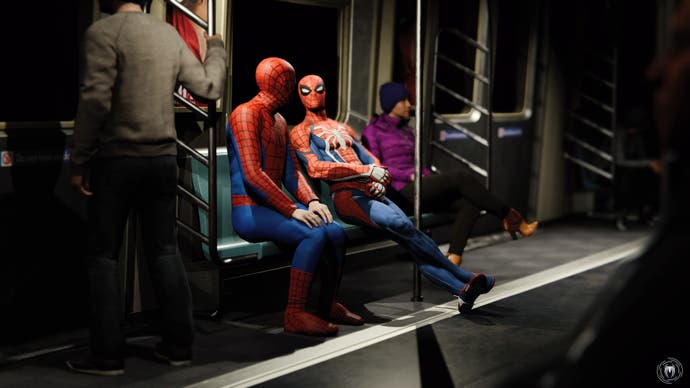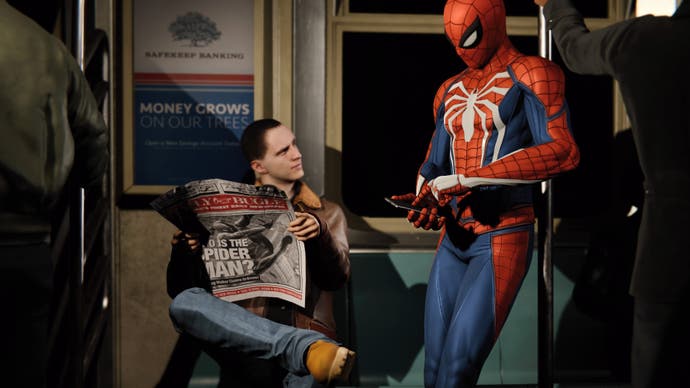The fast travel in Spider-Man is touched with genius
And a bit about the Morellian method.
There is little reason to use fast travel in Marvel's Spider-Man. Manhattan, as Insomniac Games draws it, is a sparkling but compact metropolis: no two points are far apart. More importantly, getting from A to B is an authentic delight for this particular Spider-Man. The web-swinging is endlessly enjoyable with its lullaby see-sawing between the city streets and the wild blue sky. Why would you want to skip all that just to get to your destination a few seconds sooner?
If you do use fast travel, however, you'll realise afresh just what a charming outfit Insomniac Games truly seems to be. Fast travel is handled with a loading screen, sure, but what a screen! Here's Spidey on the subway, in full costume, checking his phone, arm hanging from an overhead strap, swaying gently with the shuffle of the carriage. There are several takes on this idea, inevitably. In one of them he nods along with a stereo that's been propped on a seat next to him. In another, a man is asleep and resting his head on Spider-Man's shoulder. There is something brilliant about Spider-Man, in costume, amongst the disinterested crush of fellow travellers. Batman would never ride the tube like this.

It's partly a comment on player desire, I guess. You wanted fast travel in a game in which non-fast travel is the defining joy? Well here you go, then. Partly, though, it's something that I think more games should try and have a go at. There is a special kind of richness to what Insomniac's doing here, which is essentially squeezing a joke - and a little bit of character and world-building - into a place where most games play it straight. It speaks of luxury, of a game design team who are alert to the possibilities in every moment. Reading Giada's piece on RPG Maker recently, I was struck by the fact that middleware engines sometimes come with their own save systems and that kind of jazz pre-packaged. Even when they don't, designers sometimes seem to feel that there is a cut-off point for creativity, a place where it is acceptable to revert to type, because nobody's really paying attention, and nobody's expecting anything special.
This reminds me of two things. The first is that Insomniac has form in this area. One of the pleasures of Sunset Overdrive - a game I continue to love, and I hope it gets a PC release eventually - was the way it handled character respawns. If you died on the battlefield, you didn't just pop back up a few seconds later. You might be pushed out of a speeding van as it rushed around a corner. You might emerge from a sarcophagus in mummy wrappings. You might bust out of a Bill and Ted phone booth. Who else thinks this much about respawning in a game? Sunset Overdrive had the kind of atmosphere where wall-breaking popco riffing was very much acceptable, but even so it felt like a special kind of generosity to spend so much time and effort making something so rote feel so special. It was particularly welcome - the same is true of fast travel in Spider-Man - given that the basics of the game were so familiar and well-travelled. We're giving you something we know you like elsewhere, the game seemed to be saying, so in this little detail we're going to give you something you probably don't expect.

The other thing it reminds me of is an art critic from the 19th century called Giovanni Morelli. As grinding as that gear change is, Morelli is authentically interesting, I think. The part of his work I know about was focused on the tricky area of attribution: you have a painting, but it is unsigned - so who painted it?
As I understand it, Morelli's insight - and it has been disputed - was that people should focus not on the big details of the painting, but on the little things, because these are the things that an artist would paint on a sort of autopilot, so you would have the best chance of glimpsing a little of their creative DNA as it moved from one work to the next. In other words, Morelli was a great studier of ears and hands and that sort of stuff in paintings. Nobody wakes up in the Renaissance, I am guessing, and says, man, I am going to give St Paul the most fantastic ears today. They focus their efforts - and their creativity - on the bigger things at play, and St Paul gets the same kind of ears that everybody gets in this painter's particular work.
It's often noted that Morelli's books look like books of mug shots from another dimension: page after page of hands, of ears, of anything that is painted without too much in the way of conscious thought. I wonder what a Morellian study of games would look like. All but identical save systems, all but identical pause screens, all but identical fast-travel loading pages, with all but identical tool-tips swapped in and out along the bottom.
And then Spider-Man, riding the rails, nodding off in the crowd. Amazing.

